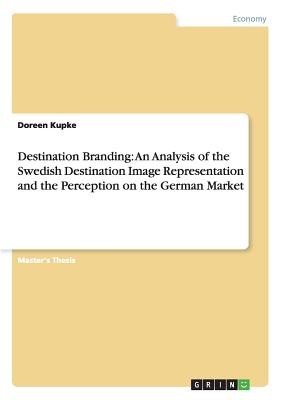
- We will send in 10–14 business days.
- Author: Doreen Kupke
- Publisher: GRIN Verlag
- Year: 2014
- Pages: 166
- ISBN-10: 3656677875
- ISBN-13: 9783656677871
- Format: 14.8 x 21 x 1 cm, softcover
- Language: English
- SAVE -10% with code: EXTRA
Reviews
Description
Master's Thesis from the year 2013 in the subject Tourism - Miscellaneous, grade: 1,0, University of Applied Sciences Heide, language: English, abstract: Destinations are one of the tourism industries biggest brands. Nowadays, travelers are overwhelmed with places, which fit in their holiday scheme. The tourism market is crowded by destinations and the outcome is the substitutability of places. (Pike, 2005) Destination branding is a way to differentiate a destination from its existing competitors. Branding a country is a complex and multilevel business. One of the core aspects in destination branding is to identify and differentiate a destination through to a positive destination image. The destination image is a crucial part in the travelers' decision making process and verifiable influence the tourist behavior. Therefore the destination image has become one of the major concepts in destination marketing. Special focus is given to the destination image theory, which is a major aspect in destination branding. (Echtner & Ritchie, 2003; Qu et al., 2011; Wang & Pizam, 2011) Just as product brands, destination brands are living entities. They have to be managed continuously and changed over time, to ensure a fit to environmental changes. (Wang & Pizam, 2011) Sweden has therefore developed a national branding and sales strategy for the tourism industry to implement until 2020 and fully launched in 2013. (GaÃmann, 2013) A part of this strategy is the creation of special themes to present a holistic Sweden image and destination brand. (Communication Guide, 2013) Among others, this strategy will be used to compare the presented and advertised Sweden image with the image perception on the German source market, to analyze compliance or incongruity. Germany is an interesting and important source market for the Swedish tourism industry. According to the research of the UNWTO, Germany is one of the biggest spenders in the tourism industry in 2011 (UNWTO, 2012). Based
EXTRA 10 % discount with code: EXTRA
The promotion ends in 17d.15:02:30
The discount code is valid when purchasing from 10 €. Discounts do not stack.
- Author: Doreen Kupke
- Publisher: GRIN Verlag
- Year: 2014
- Pages: 166
- ISBN-10: 3656677875
- ISBN-13: 9783656677871
- Format: 14.8 x 21 x 1 cm, softcover
- Language: English English
Master's Thesis from the year 2013 in the subject Tourism - Miscellaneous, grade: 1,0, University of Applied Sciences Heide, language: English, abstract: Destinations are one of the tourism industries biggest brands. Nowadays, travelers are overwhelmed with places, which fit in their holiday scheme. The tourism market is crowded by destinations and the outcome is the substitutability of places. (Pike, 2005) Destination branding is a way to differentiate a destination from its existing competitors. Branding a country is a complex and multilevel business. One of the core aspects in destination branding is to identify and differentiate a destination through to a positive destination image. The destination image is a crucial part in the travelers' decision making process and verifiable influence the tourist behavior. Therefore the destination image has become one of the major concepts in destination marketing. Special focus is given to the destination image theory, which is a major aspect in destination branding. (Echtner & Ritchie, 2003; Qu et al., 2011; Wang & Pizam, 2011) Just as product brands, destination brands are living entities. They have to be managed continuously and changed over time, to ensure a fit to environmental changes. (Wang & Pizam, 2011) Sweden has therefore developed a national branding and sales strategy for the tourism industry to implement until 2020 and fully launched in 2013. (GaÃmann, 2013) A part of this strategy is the creation of special themes to present a holistic Sweden image and destination brand. (Communication Guide, 2013) Among others, this strategy will be used to compare the presented and advertised Sweden image with the image perception on the German source market, to analyze compliance or incongruity. Germany is an interesting and important source market for the Swedish tourism industry. According to the research of the UNWTO, Germany is one of the biggest spenders in the tourism industry in 2011 (UNWTO, 2012). Based


Reviews